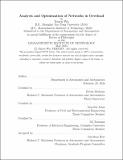Analysis and Optimization of Networks in Overload
Author(s)
Wu, Xinyu
DownloadThesis PDF (4.417Mb)
Advisor
Modiano, Eytan
Terms of use
Metadata
Show full item recordAbstract
Network overload occurs when the demand of network users exceeds the network capacity. The increasing gap between the growth of network demand and capacity, resulting from the surge in data-intensive machine learning applications and the slowdown in Moore’s law, led to more frequent and severe occurrences of network overload in recent years. Severe overload induces heavy congestion with high delay and packet loss, impairing network performance. In this thesis, we develop new models and methods to gain in-depth understanding of network overload in two aspects: (i) designing network control policies to optimize network performance; (ii) quantifying the capability of malicious routing attacks to induce network overload. We first investigate network policy design to optimize multiple network performance metrics including delay, fairness, and stability. We leverage a deterministic fluid queueing model which regards packets as continuous flows to overcome the bottlenecks of the classic stochastic models with discrete packets in order to optimize the three metrics. (i) Delay: We establish the sets of transmission policies that can minimize the average and maximum queueing delay in both single-hop and multi-stage switching networks explicitly. We term the policies rate-proportional policies since they require an identical ratio between the ingress and egress rates of different nodes at the same layer of the network. We further generalize them to queue-proportional policies, which asymptotically minimizes queueing delay based on the real-time queue backlogs agnostic of packet arrival rates. (ii) Fairness: We identify that the existing policies that can balance the overload in networks with unbounded node buffers may not work given bounded buffer sizes. We propose a policy that combines Maxweight scheduling and Backpressure routing which can reach the most balanced queue overload in networks with bounded buffers. (iii) Stability: We demonstrate that the introduction of bounded node buffers affects the transmission policies that can guarantee queue stability and avoid queue overload. We derive an explicit set of transmission policies that can guarantee queue stability in both single-commodity and multi-commodity networks with bounded node buffers. We then quantify the capability of network adversaries to induce network overload via routing attacks, where a subset of nodes is hijacked and the adversary can manipulate their packet forwarding. We consider two objectives of routing attacks: no-loss throughput minimization and loss maximization. The first objective attempts to minimize the network’s throughput that is guaranteed to survive, and the second objective attempts to maximize the packet loss due to link overflow given the traffic demand. We start from networks with static routing. We propose exact algorithms in general multi-hop networks for the first objective, and two approximation algorithms with multiplicative and additive guarantees in single-hop networks for the second objective. We then extend our approach to networks with dynamic routing, where nodes that are not hijacked can optimize their routing policies to maximize network throughput in response to routing attacks on hijacked nodes. We show that the two objectives are equivalent in this case, and propose an algorithm based on dynamic programming with performance guarantee when the hijacked nodes are in a chain structure or parallel to each other. We demonstrate the near-optimality of the proposed algorithms through simulations over a wide range of network settings with either static or dynamic routing control, which demonstrates their ability to evaluate the potential throughput loss due to overload under malicious routing, and identify the critical nodes to be protected to reduce the impact of routing attack.
Date issued
2024-05Department
Massachusetts Institute of Technology. Department of Aeronautics and AstronauticsPublisher
Massachusetts Institute of Technology